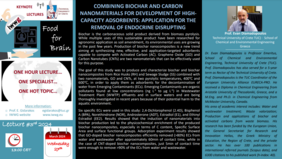Ο Ομ. Καθηγητής του Πολυτεχνείου Κρήτης κ. Ευάγγελος Γιδαράκος, συνεχίζει και φέτος την υλοποίηση διαδικτυακών διαλέξεων σε φλέγοντα θέματα διαχείρισης αποβλήτων, με τίτλο "FOOD for BRAIN".
Την Τετάρτη 27 Μαρτίου 2024 και ώρα 13:00 CET (14:00 ώρα Ελλάδος) ο Ομ. Καθηγητής Ευάγγελος Διαμαντόπουλος της Σχολής Χημικών Μηχανικών και Μηχανικών Περιβάλλοντος του Πολυτεχνείου Κρήτης θα επικεντρωθεί στην ανάπτυξη προσροφητών υψηλής ικανότητας και στην εφαρμογή τους στην επεξεργασία υγρών αποβλήτων.
Η ομιλία του έχει τίτλο: «Συνδυασμός Βιοεξανθρακώματος και Νανοϋλικών με βάση τον Άνθρακα για την ανάπτυξη προσροφητών υψηλής ικανότητας: Εφαρμογή για την απομάκρυνση των ενδοκρινικών διαταρακτών»
Συμμετοχή μπορεί να πραγματοποιηθεί μέσω του συνδέσμου: ZOOM Meeting
Τίτλος
Combining Biochar and Carbon Nanomaterials for Development of High Capacity Adsorbents: Application for the Removal of Endocrine Disrupting
Περίληψη
Biochar is the carbonaceous COMPOUNDS FROM WATER solid product derived from biomass pyrolysis. While multiple uses of this sustainable product have been researched for agronomic application as soil amendment, its environmental uses are growing in the past few years. Production of biochar nanocomposites is a new trend aiming at synthesizing new, effective, and application-targeted adsorbents capable to compete with Activated Carbon (AC). Graphene Oxide (GO) and Carbon Nanotubes (CNTs) are two nanomaterials that can be effectively used for this purpose. The goal of this study was to produce and characterize biochar and biochar nanocomposites from Rice Husks (RH) and Sewage Sludge (SS) combined with two nanomaterials, GO and CNTs, at two pyrolytic temperatures, 400℃ and 600℃, in order to apply them as adsorbents for the decontamination of water from Emerging Contaminants (ECs). Emerging Contaminants are organic pollutants found at low concentrations (ng L -1 to μg L -1) in Wastewater Treatment Plant (WWTP) effluents and in surface waters and are being thoroughly investigated in recent years because of their potential harm to the aquatic environment. Six specific ECs were used in this study: 2,4-Dichlorophenol (2.4D), Bisphenol A (BPA), Norethindrone (NOR), Androsterone (ADT), Estradiol (E1), and Ethinyl Estradiol (EE2). Results showed that the induction of nanomaterials into biochar production led to the physicochemical enrichment of the produced biochar nanocomposites, especially in terms of C content, Specific Surface Area and surface functional groups. Adsorption experiment results showed that GO-doped biochar nanocomposites efficiently removed (>80%) ECs from water and wastewater after approximately 60min of contact time, while in the case of CNT-doped biochar nanocomposites, just 5min of contact time were enough to remove >90% of the ECs from water and wastewater.
Βιογραφικό
Ο Ευάγγελος Διαμαντόπουλος είναι Ομότιμος Καθηγητής της Σχολής Χημικών Μηχανικών και Μηχανικών Περιβάλλοντος. Από τον Δεκέμβριο του 2017 έως και τον Αύγουστο του 2022 υπηρέτησε ως εκλεγμένος Πρύτανης του Πολυτεχνείου Κρήτης. Από το Νοέμβριο του 2020 έως τώρα, υπηρετεί ως ο Επιστημονικά Υπεύθυνος για το Πολυτεχνείο Κρήτης στο έργο συνεργασίας μεταξύ εννέα Ευρωπαϊκών Πανεπιστημίων για την δημιουργία του European University on Responsible Consumption and Production (EURECA-PRO). Έλαβε το Δίπλωμα του Χημικού Μηχανικού από το Αριστοτέλειο Πανεπιστήμιο Θεσσαλονίκης και το Μεταπτυχιακό και Διδακτορικό Δίπλωμα Χημικού Μηχανικού από το McMaster University στον Καναδά. Το πεδίο της έρευνάς του εστιάζεται στην περιβαλλοντική τεχνολογία και την αξιοποίηση αποβλήτων. Έχει δημοσιεύσει πάνω από 100 άρθρα σε έγκριτα επιστημονικά περιοδικά, έχει πάνω από 6.300 αναφορές και h-index 40.
















